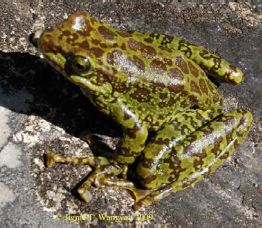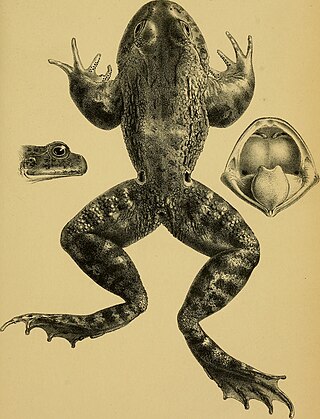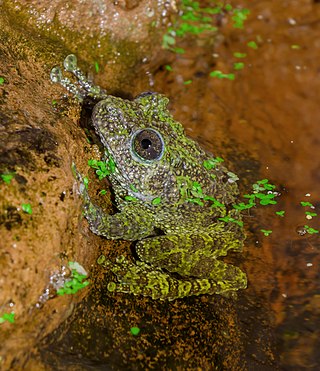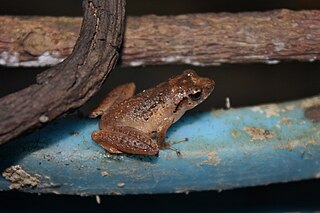
Annam tree frog, also known as the South China tree toad, is a species of frog in the family Hylidae. It is found in southern China, Vietnam, and Laos. The Hainan tree toad from Hainan Island is treated as a subspecies.
The ocellated forest tree frog is a species of frog in the family Arthroleptidae found in Cameroon, the Republic of the Congo, the Democratic Republic of the Congo, Equatorial Guinea, and Gabon, and possibly Angola and the Central African Republic. Its natural habitats are subtropical or tropical moist lowland forest, swamps, and heavily degraded former forests. It is threatened by habitat loss.
Leptobrachium hainanense, the Hainan pseudomoustache toad, is a species of amphibian in the family Megophryidae. It is endemic to the mountains of central and southwestern Hainan Island, China. Before being recognized as a separate species, it was confused with Leptobrachium hasseltii.
Limnonectes fragilis is a species of frog in the family Dicroglossidae. It is endemic to the Hainan Island, China. It is a medium-sized frog, males being 49 mm (1.9 in) and females 52 mm (2.0 in) snout-vent length. Its natural habitats are subtropical or tropical moist lowland forest and rivers. It is threatened by habitat loss.
Amolops loloensis is a species of frog in the family Ranidae that is found in southern and western Sichuan and one locality in north-central Yunnan, China. Its natural habitats are small mountain streams in forests and grasslands. It is threatened by infrastructure development for human settlement, potentially also by water pollution from the mining industry. T

Amolops mantzorum, commonly known as the Sichuan torrent frog or Kangting sucker frog, is a species of frog in the family Ranidae. It is found in Gansu, Sichuan, and Yunnan Provinces of China. It has recently been reported also from Bhutan.

Quasipaa exilispinosa is a species of frog in the family Dicroglossidae. It is known under many common names, including Hong Kong spiny frog, common spiny frog, lesser spiny frog, little spiny frog, and Hong Kong paa frog. It has a patchy distribution in southern China including Hong Kong. Its natural habitats are subtropical hill streams in forests or shrublands, and sometimes also seepages, stream-fed marshes, and forests. It is threatened by over-collecting for human consumption and by habitat loss.

Nanorana feae is a species of frog in the family Dicroglossidae. It is found in Yunnan, China, and the Kachin Hills in Myanmar. The specific name feae honors Leonardo Fea, an Italian explorer, zoologist, and naturalist. This little-known species probably inhabits hill streams in forested areas.
Odorrana exiliversabilis is a species of frogs in the family Ranidae that is endemic to southeastern China where it is found in Fujian, western Zhejiang, and southern Anhui provinces. These frogs can be found in mountain forest streams and are common in suitable habitat. The species is not considered threatened by the IUCN.
Odorrana hainanensis is a species of frogs in the family Ranidae that might be endemic to Hainan Island, China; there is one record from Guangxi. Prior to its description in 2001, it was confused with Odorrana andersonii.
Odorrana nasuta is a species of frogs in the family Ranidae that is endemic to Hainan, China. It occurs near streams in forested regions at elevations of 350–850 m (1,150–2,790 ft) asl. Breeding takes place in streams. It is threatened by habitat loss caused by smallholder farming activities and clear-cutting of forests.
Buergeria oxycephala is a species of frog in the family Rhacophoridae. It is endemic to Hainan Island, China.
Liuixalus hainanus is a species of frog in the family Rhacophoridae. It is endemic to Hainan Island, China, and only known from its type locality, Mount Diaoluo in Lingshui Li Autonomous County.

Theloderma corticale is a species of frog in the family Rhacophoridae. It is found in northern Vietnam, south–central Laos, and southern China.
Hylarana spinulosa, also known as fine-spined frog and spiny frog, is a species of true frog, family Ranidae. It is endemic to Hainan, southern China. It occurs in tropical forests at elevations of 80–840 m (260–2,760 ft) above sea level. Breeding takes place in pools and slow-flowing streams.
Gracixalus gracilipes, commonly known as the Chapa bubble-nest frog, black eye-lidded small tree frog, yellow and black-spotted tree frog or slender-legged bush frog, is a species of shrub frog from northern Vietnam, southern China, and northwestern Thailand.
Zhangixalus yinggelingensis is a species of frog in the family Rhacophoridae endemic to Yinggeling National Nature Reserve, Hainan, China. Its specific name refers to the type locality, Yinggeling, a mountain range in central Hainan.

Liuixalus is a small genus of rhacophorid frogs that are distributed in southern China. Some species now in Romerus were originally placed in Philautus. It is thought to be the most basal genus in the Rhacophorinae.
Ocellated frog may refer to:






